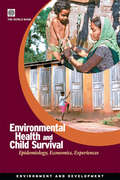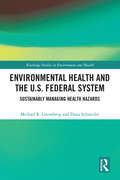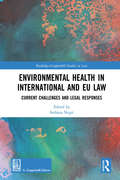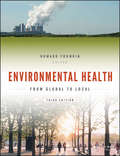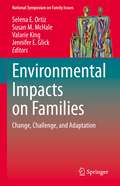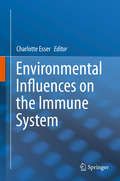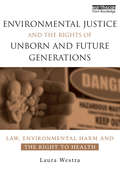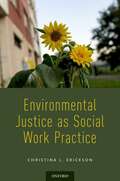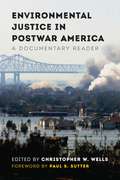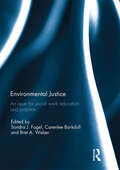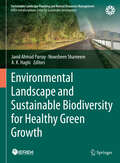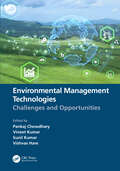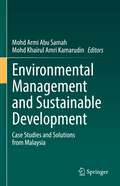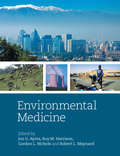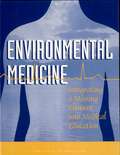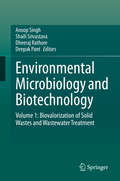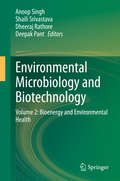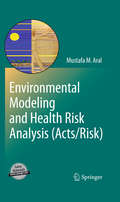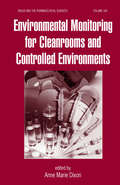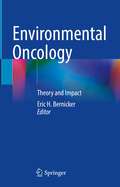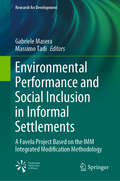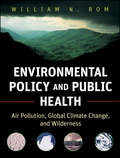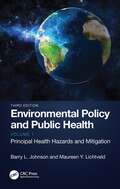- Table View
- List View
Environmental Health and Child Survival
by World BankEach year, millions of children in developing countries fall sick and die from diseases caused by polluted air, contaminated water and soil, and poor hygiene behavior. Repeated infectious also contribute to malnutrition in children, and subsequently impacts future learning and productivity. This book analyzes the linkages between malnutrition and environmental health, and assesses the burden of disease on young children, and its economic costs.
Environmental Health and the U.S. Federal System: Sustainably Managing Health Hazards (Routledge Studies in Environment and Health)
by Michael R Greenberg Dona SchneiderThis book explains how the U.S. federal system manages environmental health issues, with a unique focus on risk management and human health outcomes. Building on a generic approach for understanding human health risk, this book shows how federalism has evolved in response to environmental health problems, political and ideological variations in Washington D.C, as well as in-state and local governments. It examines laws, rules and regulations, showing how they stretch or fail to adapt to environmental health challenges. Emphasis is placed on human health and safety risk and how decisions have been influenced by environmental health information. The authors review different forms of federalism, and analyse how it has had to adapt to ever evolving environmental health hazards, such as global climate change, nanomaterials, nuclear waste, fresh air and water, as well as examining the impact of robotics and artificial intelligence on worker environmental health. They demonstrate the process for assessing hazard information and the process for federalism risk management, and subsequently arguing that human health and safety should receive greater attention. This book will be essential reading for students and scholars working on environmental health and environmental policy, particularly from a public health, and risk management viewpoint, in addition to practitioners and policymakers involved in environmental management and public policy.
Environmental Health in International and EU Law: Current Challenges and Legal Responses (Routledge-Giappichelli Studies in Law)
by Stefania NegriThis book presents a broad overview of the many intersections between health and the environment that lie at the basis of the most crucial environmental health issues, focusing on the responses provided by international and EU law. Consistent with the One Health approach and moving from the relevant international and EU legal frameworks, the book addresses some of the most important issues of environmental health including the traditional, such as pollution of air, water and soil and related food safety issues, as well as new and emerging challenges, like those linked to climate change, antimicrobial resistance and electromagnetic fields. Applying an intersectoral and interdisciplinary approach, it also investigates other branches of international and EU law including human rights law, investment law, trade law, energy law and disaster law. The work also discusses ethics and intergenerational equity. Ultimately, the book assesses the degree of effectiveness of the international and EU normative framework, and the extent to which the relevant legal instruments contribute to the protection of public health from major environmental hazards. The book will be a valuable resource for students, academics and policy makers working in the areas of Environmental Health law, Global Health law, International law and EU law.
Environmental Health: From Global to Local (Public Health/Environmental Health)
by Howard FrumkinThe bestselling environmental health text, with all new coverage of key topics Environmental Health: From Global to Local is a comprehensive introduction to the subject, and a contemporary, authoritative text for students of public health, environmental health, preventive medicine, community health, and environmental studies. Edited by the former director of the CDC's National Center for Environmental Health and current dean of the School of Public Health at the University of Washington, this book provides a multi-faceted view of the topic, and how it affects different regions, populations, and professions. In addition to traditional environmental health topics—air, water, chemical toxins, radiation, pest control—it offers remarkably broad, cross-cutting coverage, including such topics as building design, urban and regional planning, energy, transportation, disaster preparedness and response, climate change, and environmental psychology. This new third edition maintains its strong grounding in evidence, and has been revised for greater readability, with new coverage of ecology, sustainability, and vulnerable populations, with integrated coverage of policy issues, and with a more global focus. Environmental health is a critically important topic, and it reaches into fields as diverse as communications, technology, regulatory policy, medicine, and law. This book is a well-rounded guide that addresses the field's most pressing concerns, with a practical bent that takes the material beyond theory. Explore the cross-discipline manifestations of environmental health Understand the global ramifications of population and climate change Learn how environmental issues affect health and well-being closer to home Discover how different fields incorporate environmental health perspectives The first law of ecology reminds is that 'everything is connected to everything else.' Each piece of the system affects the whole, and the whole must sustain us all for the long term. Environmental Health lays out the facts, makes the connections, and demonstrates the importance of these crucial issues to human health and well-being, both on a global scale, and in our homes, workplaces, and neighborhoods.
Environmental Impacts on Families: Change, Challenge, and Adaptation (National Symposium on Family Issues #12)
by Valarie King Susan M. McHale Jennifer E. Glick Selena E. OrtizThis book examines ways in which families’ physical environments have implications for their relationships and the health and well-being of their members. Attention is given to three aspects of the physical environment—disasters, climate change, and the built environment—and the challenges these may create for families. Chapters describe particular considerations within each of these three physical environment challenges, the ways they affect families, and factors that protect families, promote their resilience and enable them to flourish. Finally, the volume offers recommendations for the role of government programs and policies to support families to overcome and/or adapt to environmental challenges as well as highlights the efficacy of evidence-based interventions aimed at promoting family resilience.Featured areas of coverage include: Extreme natural events and families’ postdisaster recovery.Family adaptations to climate change.The built environment and children’s health and well-being.Community-driven approaches to address environmental inequities.The urban environment of family caregiving. Environmental Impacts on Families is a must-have resource for researchers, professors, and graduate students as well as clinicians, therapists, policymakers, and other related professionals in developmental psychology, family studies, environmental health and policy, social work, public health, educational policy and politics, economics, migration studies, and all interrelated disciplines.
Environmental Influences on the Immune System
by Charlotte EsserThis book brings together articles on the overarching theme of how the environment shapes the immune system. The immune system is commonly assumed to respond to harmful pathogens such as bacteria and viruses. However, harmless bacteria, chemicals, stress, normal food and other factors can also trigger, shape or interfere with the immune system, often producing adverse effects. Yet, it is also becoming increasingly accepted that some of these interactions are physiological and necessary for a healthy immune system. Examples of negative effects include the immunosuppressive effects of UV irradiation, or the immunotoxic effects of man-made chemicals such as polycyclic aromatic hydrocarbons. Autoimmunity or allergies can be the adverse consequences of interaction between the immune system and chemical compounds such as drugs. Positive effects can come from natural exposure levels to bacteria, healthy life-style or the diet. There is a great need to understand how communication between the environment and the immune system works. This book addresses this need. It covers environmental factors (such as bacteria, sun exposure), human factors (such as age, exercise or stress), and important man-made factors (such as air pollution). A chapter on human rights complements the scientific chapters. The book is intended for immunologists, toxicologists and researchers who want to know how the immune system works and is triggered, as well as for medical doctors in environmental medicine and the general public interested in immunology.
Environmental Justice and the Rights of Unborn and Future Generations: Law, Environmental Harm and the Right to Health
by Laura WestraThe traditional concept of social justice is increasingly being challenged by the notion of a humankind that spans current and future generations. This book, with a foreword by Roger Brownsword, is the first systematic examination of how the rights of the unborn and future generations are handled in common law and under international legal instruments. It provides comprehensive coverage of the arguments over international legal instruments, key legal cases and examples including the Convention on the Rights of the Child, industrial disasters, clean water provision, diet, HIV/AIDS, environmental racism and climate change. Also covered are international agreements and objectives as diverse as the Kyoto Protocol, the Millennium Development Goals and international trade. The result is the most controversial and thorough examination to date of the subject and the enormous ramifications and challenges it poses to every aspect of international and domestic environmental, human rights, trade and public health law and policy.
Environmental Justice as Social Work Practice
by Christina L. EricksonThis book places the natural environment as central to practice. Utilizing the Phases of Practice and micro to macro levels of practice, the book integrates neatly into a college semester course. Chapters cover important components of social work such as theory, ethics, conceptual foundations as well as distinct chapters on micro, mezzo, and macro practice. Each chapter expands the discipline's commitment to and applied efforts in the environmental movement while recognizing the unique contributions social work has to offer to ameliorate environmental inequities. Chapters include real-world stories from environmental social work practitioners, case studies, and boxed sections highlighting organizations and people who bridge the human and natural justice divide. Each chapter concludes with learning activities and critical thinking questions providing learning activities that map easily to a course syllabus. A matrix identifying the placement of educational competencies from the Council on Social Work Education is included. The textbook provides a framework for social work educators to bravely and competently teach environmental social work as a stand-alone college course or to incorporate into a traditional practice course.
Environmental Justice in Postwar America: A Documentary Reader (Weyerhaeuser Environmental Classics)
by Christopher Wells Paul Sutter<p>In the decades after World War II, the American economy entered a period of prolonged growth that created unprecedented affluence'but these developments came at the cost of a host of new environmental problems. Unsurprisingly, a disproportionate number of them, such as pollution-emitting factories, waste-handling facilities, and big infrastructure projects, ended up in communities dominated by people of color. Constrained by long-standing practices of segregation that limited their housing and employment options, people of color bore an unequal share of postwar America's environmental burdens. <p>This reader collects a wide range of primary source documents on the rise and evolution of the environmental justice movement. The documents show how environmentalists in the 1970s recognized the unequal environmental burdens that people of color and low-income Americans had to bear, yet failed to take meaningful action to resolve them. Instead, activism by the affected communities themselves spurred the environmental justice movement of the 1980s and early 1990s. By the turn of the twenty-first century, environmental justice had become increasingly mainstream, and issues like climate justice, food justice, and green-collar jobs had taken their places alongside the protection of wilderness as ?environmental? issues. <p>Environmental Justice in Postwar America is a powerful tool for introducing students to the US environmental justice movement and the sometimes tense relationship between environmentalism and social justice.</p>
Environmental Justice: An Issue for Social Work Education and Practice
by Sondra J. Fogel Carenlee Barkdull Bret A. WeberWhat is environmental justice? Why is it important to social work? Social work has a long history with the term "environment" as part of our guiding Ecological Framework. Yet frequently, the assessment of the environment is left out or seen as a difficult domain to understand as part of the complexities of the human experience, particularly for those who are vulnerable, oppressed and poor. This book contains nine articles that showcase environmental justice work in social work practice and in educational settings from around the world. The profession now seems ready to ensure that the "environment" is once again given the consideration it deserves when we are assessing problems in living. These articles were selected for their helpfulness in moving the profession forward conceptually while offering practical tools for the classroom, institutions, and for further scholarship. This book was originally published as a special issue of Social Work Education: The International Journal.
Environmental Landscape and Sustainable Biodiversity for Healthy Green Growth (Sustainable Landscape Planning and Natural Resources Management)
by Javid Ahmad Parray A. K. Haghi Nowsheen ShameemThis unique reference book represents sustainable development of UN for providing a proper life standard and mobility for people. The 17 sustainable development goals (SDGs) as set by the United Nations for 2030 are the most basic prerequisite for the growth and development of national health. This book also provides broad case studies to show the interconnection of sustainable development goals of healthy lifestyle that will have enormous impacts on proper environmental health standards. In this advanced reference book, the authors will invite experts from around the globe to help the readers to better understand the interconnection between the UN sustainable development goals and environmental sustainability for 2030. To achieve these goals, the authors have divided this reference book into four sections: The first section of this research-oriented book is devoted to reviewing the basic concepts of the healthy environmental sustainable development goals by considering the current world population of 7 billion. The plan is that the chapters selected in this section should provide the most important aspects needed in detail. In Section 2, to reach novel technology innovations for making changes in environment health policy, the requirements for making remarkable challenges along with the global economy are reviewed. Section 3 is used as a practical guide for postgraduate students interested in gaining their knowledge in the area of the environmental sustainability without a strong background in all 17 (SDGs) as set by the United Nations for 2030 and the different aspects of the sustainability for a healthier lifestyle. ϖ Section 4 addresses case studies to cover conceptual framework on how to better understand the sustainability goals and synergies among organic food, green energy, and clean water technologies. It also exchanges valuable experiments in this multidisciplinary field by renowned research scientists.
Environmental Management Technologies: Challenges and Opportunities
by Sunil Kumar Vineet Kumar Pankaj Chowdhary Vishvas HareEnvironmental Management Technologies: Challenges and Opportunities details the environmental problems posed by the various types of toxic organic and inorganic pollutants discharged from both natural and anthropogenic activities and their toxicological effects in environments, humans, animals, and plants. This book also highlights the recent advanced and innovative methods for the effective degradation and bioremediation of organic pollutants, heavy metals, dyes, etc. from the environment for sustainable development. Features of the book: · Provides state-of-the-art information on pollutants, their sources, and deleterious impacts on the environment · Elucidates the recent updates on Emerging Pollutants (EPs) in pharmaceutical waste and personal care products · Discusses the various physico-chemical, biological, and combination treatment systems for sustainable development · Details recent research findings in the area of environmental waste management and their future challenges and opportunities
Environmental Management and Sustainable Development: Case Studies and Solutions from Malaysia
by Mohd Armi Abu Samah Mohd Khairul Amri KamarudinThis volume provides case studies conducted in Malaysia based on environmental management and the sustainable development of human and ecological systems. The first chapter discusses awareness studies in environmental management in Terengganu, Malaysia. The second chapter is about human health risk assessment of heavy metals exposure due to freshwater fish ingestion from Sungai Kuantan, Malaysia. The third chapter discusses nickel and cadmium pollution in freshwater fishes in Kuantan River and Riau River. Chapter four discusses tourism sustainability. Chapters five and six provide an overview on particulate matter emissions at construction sites, and municipal solid waste (MSW) management approaches. In chapter seven, the book provides a general overview on cellulose and cellulose nanocrystals extraction. Finally, chapters eight and nine discuss legal measures for wildlife protection in Malaysia, and how improved environmental management practices are needed to achieve this. The book is intended for environmental managers, wildlife organizations, and students and researchers studying sustainable development, waste management, and corporate impacts on the environment.
Environmental Medicine
by Jon Ayres Roy Harrison Gordon Nichols Robert Maynard CBEEnvironmental Medicine is an indispensable aid to the investigation, diagnosis and treatment of a wide variety of environmentally-acquired disorders. It brings into sharp focus the increasing importance of the practice of environmental medicine, drawing together the many different strands that make up this modern discipline, and putting topical and
Environmental Medicine: Integrating a Missing Element into Medical Education
by Committee on Curriculum Development in Environmental MedicinePeople are increasingly concerned about potential environmental health hazards and often ask their physicians questions such as: "Is the tap water safe to drink?" "Is it safe to live near power lines?" Unfortunately, physicians often lack the information and training related to environmental health risks needed to answer such questions. This book discusses six competency based learning objectives for all medical school students, discusses the relevance of environmental health to specific courses and clerkships, and demonstrates how to integrate environmental health into the curriculum through published case studies, some of which are included in one of the book's three appendices. Also included is a guide on where to obtain additional information for treatment, referral, and follow-up for diseases with possible environmental and/or occupational origins.
Environmental Microbiology and Biotechnology: Volume 1: Biovalorization of Solid Wastes and Wastewater Treatment
by Anoop Singh Dheeraj Rathore Deepak Pant Shaili SrivastavaThis book provides up-to-date information on the state of the art in applications of biotechnological and microbiological tools for protecting the environment. Written by leading international experts, it discusses potential applications of biotechnological and microbiological techniques in solid waste management, wastewater treatment, agriculture, energy and environmental health. This first volume of the book “Environmental Microbiology and Biotechnology,” covers three main topics: Solid waste management, Agriculture utilization and Water treatment technology, exploring the latest developments from around the globe regarding applications of biotechnology and microbiology for converting wastes into valuable products and at the same time reducing the environmental pollution resulting from disposal. Wherever possible it also includes real-world examples. Further, it offers advice on which procedures should be followed to achieve satisfactory results, and provides insights that will promote the transition to the sustainable utilization of various waste products.
Environmental Microbiology and Biotechnology: Volume 2: Bioenergy and Environmental Health
by Anoop Singh Dheeraj Rathore Deepak Pant Shaili SrivastavaThis book provides up-to-date information on the state of the art in applications of biotechnological and microbiological tools for protecting the environment. Written by leading international experts, it discusses potential applications of biotechnological and microbiological techniques in solid waste management, wastewater treatment, agriculture, energy and environmental health. This second volume of book “Environmental Microbiology and Biotechnology,” covers two main topics: bioenergy and environmental health, exploring the latest developments from around the globe regarding applications of biotechnology and microbiology for converting wastes into valuable products and at the same time reducing the environmental pollution resulting from disposal. Wherever possible it also includes real-world examples. Further, it offers advice on which procedures should be followed to achieve satisfactory results, and provides insights that will promote the transition to the sustainable utilization of various waste products.
Environmental Modeling and Health Risk Analysis (Acts/Risk)
by Mustafa M. AralThis book is intended to serve as a comprehensive source for the advancements and contributions made in environmental transformation and transport modeling in general and the associated health risk assessment topics in particular. The selection of the title, "Environmental Modeling and Health Risk Analysis" stems from an ambitious objective of providing a review of air, surface water and groundwater quality modeling topics and linking these models with exposure and health risk analysis. Thus, the purpose is to provide the reader with an integrated perspective on these two seemingly distant fields. The ACTS and RISK software that is an integral part of this book include computational platforms for all models discussed in the book. Using these two software tools, available from http://extras.springer.com/ , the models described in the book can be readily accessed and used in classroom or professional applications as demonstrated in the book.
Environmental Monitoring for Cleanrooms and Controlled Environments (Drugs and the Pharmaceutical Sciences)
by Anne Marie DixonA critical technology in the science of contamination control, environmental monitoring is a technique that provides important data on the quality of a process, processing environment, and final product, which can aid scientists in identifying and eliminating potential sources of contamination in cleanrooms and controlled environments. In response
Environmental Oncology: Theory and Impact
by Eric H. BernickerThis book covers the wide range of malignant illness and where they intersect with environmental factors. Chapters explore the importance of acknowledging and dealing with the societal implications of anthropogenic climate change, a wider appreciation of the many ways that human industry and activity is changing the environment and contributing to human disease is imperative. In addition to how particular exposures relate to certain malignancies, the book explores historical events that led to the development of cancers in order to help policy makers and patient advocates understand where we have been when considering future initiatives. It also discusses the disparities involved in environmental toxin exposure and look at these cancers in light of the need to reduce cancer disparities. Given the ongoing ecological crisis from climate change and expanding human population and industrialization, this book examines pollution and ecological change to impacts and where human disease can be prevented.
Environmental Performance and Social Inclusion in Informal Settlements: A Favela Project Based on the IMM Integrated Modification Methodology (Research for Development)
by Gabriele Masera Massimo TadiThis book discusses the potential of a systemic and multidisciplinary design approach to improve urban quality, health, livability, and inclusiveness for people living in informal settlements. In most instances, attempts to address informal settlements lack an adequate assessment of their impact on the wider built environment and implementation of the UN’s Sustainable Development Goals. The Integrated Modification Methodology (IMM), introduced here, offers a systematic, multidisciplinary design tool encompassing several of the aspects that define the environmental performance of urban systems. The book also demonstrates the application of the methodology to an informal settlement, proving its potential to guide systemicurban transformations, also in urban areas lacking formal planning. The case study investigated is in the Rocinha favela in Rio de Janeiro, which ischaracterized by poor water quality, lack of drainage and sanitation systems, and very few green spaces. Based on a rigorous methodology, the process described here can also be applied in similar contexts around the world.
Environmental Policy and Public Health
by Barry L. Johnson Maureen Y. LichtveldAs with the first edition, this second edition describes how environmental health policies are developed, the statutes and other policies that have evolved to address public health concerns associated with specific environmental hazards, and the public health foundations of the policies. It lays out policies for what is considered the major environmental physical hazards to human health. Specifically, the authors describe hazards from air, water, food, hazardous substances, and wastes. To this list the authors have added the additional concerns from climate change, tobacco products, genetically-modified organisms, environment-related diseases, energy production, biodiversity and species endangerment, and the built environment. And as with the first edition, histories of policymaking for specific environmental hazards are portrayed. This edition differs from its antecedent in three significant themes. Global perspectives are added to chapters that describe specific environmental hazards, e.g., air pollution policies in China and India. Also there is the material on the consequences of environmental hazards on both human and ecosystem health. Additionally readers are provided with information about interventions that policymakers and individuals can consider in mitigating or preventing specific environmental hazards.
Environmental Policy and Public Health
by William N. RomThis textbook provides an overview of the major environmental policy issues, past and present, and explains the interplay among law, science, and advocacy as related to environmental policymaking in the United States and abroad. Environmental Policy and Public Health examines the main sources of pollution and threats to environmental integrity and explores the consequences of pollution on the environment and the population. Throughout the book, noted environmental policy expert William N. Rom explains the legal basis for environmental action, beginning with the Clean Air Act, the Wilderness Act, the National Environmental Policy Act, the Endangered Species Act, and international treaties. In addition to providing information about existing laws, the author presents potential policy alternatives that offer real-world solutions. Comprehensive in scope, the book incorporates developments in law, economics, global warming, and air pollution. Environmental Policy and Public Health covers these topics and also puts an emphasis on wilderness protection. An important focus of the book is an assessment of the role of policy analysis in the formation and implementation of national and local environmental policy. Companion Web site: www. josseybass. com/go/rom
Environmental Policy and Public Health: Emerging Health Hazards and Mitigation, Volume 2
by Barry L. Johnson Maureen Y. LichtveldWritten by environmental health experts with long teaching and professional careers in policy and public health, the third edition of Environmental Policy and Public Health comprises two volumes, addressing key physical hazards in the environment that impact public health. The first volume on Principal Health Hazards and Mitigation is complemented by the second volume, Emerging Health Hazards and Mitigation. Volume 2 discusses emerging health hazards and mitigation including environment-related infectious diseases, COVID-19 pandemic, social justice, and drugs and public health. New in this volume are a chapter on firearms violence as a public health hazard, a chapter on transportation and how built environments can affect human health and social well-being, and a chapter on noise and light pollution. As human populations increase and technology adds more devices to daily use that generate noise and light, adverse human and ecological health effects have become recognizable and require time-sensitive policy actions to mitigate and where possible prevent adverse health effects. Each chapter explains with great clarity how new environmental health issues are translated into public health policies. The volume concludes with case studies and practice questions to facilitate interactive learning for upper-level undergraduate and graduate students taking courses in public health and environmental sciences. The case studies and practice questions allow for a diverse portfolio of in-person and hybrid pedagogical strategies and tools at the fingertips of faculty who not only teach policy courses but whose course topics have policy relevance, such as climate and health.
Environmental Policy and Public Health: Principal Health Hazards and Mitigation, Volume 1
by Barry L. Johnson Maureen Y. LichtveldWritten by environmental health experts with long teaching and professional careers in policy and public health, the third edition of Environmental Policy and Public Health comprises two volumes addressing key physical hazards in the environment that impact public health. The first volume on Principal Health Hazards and Mitigation is complemented by the second volume, Emerging Health Hazards and Mitigation. The health of the environment is inextricably linked to that of people. Thoroughly updated, Volume 1 describes how the quality of air, water, and food is threatened by the presence of toxic substances and explains why climate change is a global health priority already impacting human health and the environment. The mitigations discussed in this volume are twofold: policies that are intended for control of specific hazards and suggested hazard interventions. The role of policy in addressing each of these key environmental health areas is extensively discussed in this volume as well. Each chapter explains step by step how new environmental health issues are translated into public health policies and concludes with practice questions to facilitate interactive learning for upper-level undergraduate and graduate students taking courses in public health and environmental sciences. The step-by step approach, as well as the case studies and practice questions, allow for a diverse portfolio of in-person and hybrid pedagogical strategies and tools at the fingertips of faculty who not only teach policy courses, but whose course topics, such as climate and health, have policy relevance.
